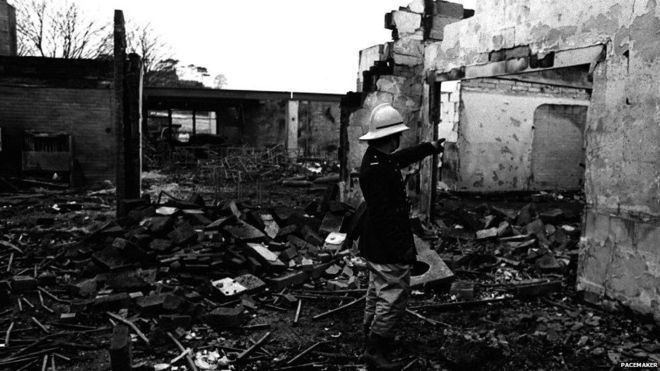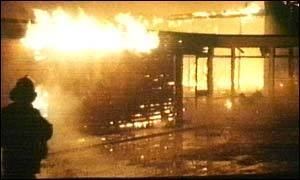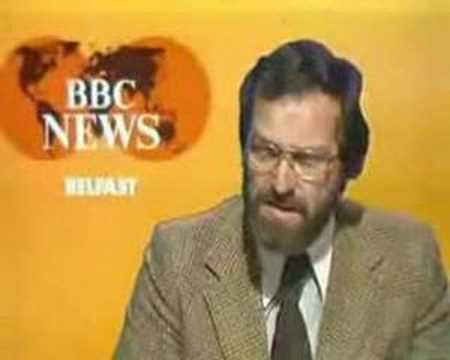Start date February 17, 1978 Attack type Bomb | Non-fatal injuries 30 Total number of deaths 12 | |
 | ||
Similar London Hilton bombing, 1971 Balmoral Furniture, Glenanne barracks bombing, RFA Fort Victoria bombing, 1972 Donegall Street bo | ||
The La Mon restaurant bombing was an incendiary bomb attack by the Provisional Irish Republican Army (IRA) on 17 February 1978 that has been described as "one of the worst atrocities" of the Troubles. It took place at the La Mon House hotel/restaurant near Belfast, Northern Ireland. The IRA left a large incendiary bomb, containing a napalm-like substance, outside one of the restaurant's windows. There were 450 diners, hotel staff and guests inside the building. The IRA members then tried to send warnings by telephone, but were unable to do so until nine minutes before it detonated. The blast created a fireball, killing twelve people and injuring thirty more, many of whom were severely burnt. Many of the injured were treated in the Ulster Hospital in nearby Dundonald.
Contents

Since the beginning of its campaign, the IRA had carried out numerous attacks on economic targets, killing many members of the public in the process. The IRA's goal was to harm the economy and cause disruption, which would put pressure on the British government to withdraw from Northern Ireland.

Belfast man Robert Murphy received 12 life sentences for the manslaughter of those who died. Murphy was freed from prison on licence in 1995. There are allegations that two of the IRA members involved were British double agents.

Warnings

On 17 February 1978, an IRA unit planted an incendiary bomb attached to petrol-filled canisters on meat hooks outside the window of the Peacock Room in the restaurant of the La Mon House Hotel, located at Gransha, County Down, about 6 miles (9.7 km) southeast of central Belfast. After planting the bomb, the IRA members tried to send a warning from the nearest public telephone, but found that it had been vandalised. On their way to another telephone they were delayed again when forced to stop at an Ulster Defence Regiment (UDR) checkpoint. By the time they were able to send the warning, only nine minutes remained before the bomb exploded at 21:00. The Royal Ulster Constabulary (RUC) base at Newtownards had received two further telephone warnings at 20:57 and 21:04. By the time the latter call came in it was too late. When an officer telephoned the restaurant to issue the warning he was told "For God's sake, get out here – a bomb has exploded!". Although the bombers tried to warn of the bomb (the IRA often gave bomb warnings when destroying property but never when targeting the police or military), a 2012 news article claimed that the IRA were targeting RUC officers they believed were meeting in the restaurant that night. The article claimed that the IRA had got the wrong date and that the meeting of RUC officers had taken place exactly a week before.
Explosion and fireball

That evening the two main adjoining function rooms, the Peacock Room and Gransha Room, were packed with people of all ages attending dinner dances. Including the hotel guests and staff, there was a total of 450 people inside the building. The diners had just finished their first course when the bomb detonated, shattering the window outside of which it was attached and vaporising the canisters. The explosion created an instantaneous and devastating fireball of blazing petrol, 40 feet high and 60 feet wide, which engulfed the Peacock Room. Twelve people were killed, having been virtually burnt alive, and a further 30 were injured, many of them critically. Some of the wounded lost limbs, but for the most part received severe burns. One badly burnt survivor described the inferno inside the restaurant as "like a scene from hell", whilst another who lost her daughter Elizabeth and son-in-law, Ian McCracken, said the blast was "like the sun had exploded in front of my eyes". There was further pandemonium after the lights had gone out and choking black smoke filled the room. The survivors, with their hair and clothing on fire, rushed to escape the burning room. It took firemen almost two hours to put out the blaze. The dead included eleven Protestant civilians and one RUC officer. Half of the victims were young married couples. Most of the dead and injured were members of the Irish Collie Club and the Northern Ireland Junior Motor Cycle Club, which were holding their yearly dinner dances in the Peacock Room and Gransha Room respectively. The former took the full force of the explosion and subsequent fire; many of those who died had been seated closest to the window where the bomb had gone off. Some of the injured were still receiving treatment 20 years later.
The device was a small blast bomb attached to four large petrol canisters, each filled with a home-made napalm-like substance of petrol and sugar. This was designed to stick to whatever it hit, a combination which caused severe burn injuries. The victims were found beneath a pile of hot ash and charred beyond recognition, making identity extremely difficult as all their individual human features had been completely burned away. Some of the bodies had shrunk so much in the intense heat, it was first believed that there were children among the victims. One doctor who saw the remains described them as being like "charred logs of wood". According to a published account by retired RUC Detective Superintendent Kevin Sheehy, this type of device had already been used by the IRA in more than one hundred attacks on commercial buildings before the La Mon attack.
Aftermath
The day after the explosion, the IRA admitted responsibility and apologised for the inadequate warning. The hotel had allegedly been targeted by the IRA as part of its firebomb campaign against commercial targets; however, the resulting carnage brought quick condemnation from other Irish nationalists, with one popular newspaper comparing the attack to the 1971 McGurk's Bar bombing. Sinn Féin president Ruairí Ó Brádaigh also strongly criticised the operation. In consequence of the botched attack, the IRA Army Council gave strict instructions to all units not to bomb buses, trains or hotels.
As all the victims had been Protestant, many Protestants saw the bombing as a sectarian attack against their community. Unionists called for the return of the death penalty. The same day, about 2,000 people attended a lunchtime service organised by the Orange Order at Belfast City Hall. Belfast International Airport also shut for an hour, while many workers in Belfast and Larne stopped work for a time. Workers at a number of factories said they were contributing a half-day's pay to a fund for the victims. Ulster loyalists criticised the then Secretary of State for Northern Ireland, Roy Mason, for his "complacent attitude" to the attack. He claimed that the explosion was "an act of criminal irresponsibility" performed "by remnants of IRA gangs". He also claimed that the IRA was on the decline.
A team of 100 RUC detectives was deployed in the investigation. As part of the investigation, 25 people were arrested in Belfast, including Gerry Adams. Adams was released from custody in July 1978. Two prosecutions followed. One Belfast man was charged with twelve murders but was acquitted. He was convicted of IRA membership but successfully appealed. In September 1981, another Belfast man, Robert Murphy was given twelve life sentences for the manslaughter of those who died. Murphy was freed on licence in 1995. As part of their bid to catch the bombers, the RUC passed out leaflets which displayed a graphic photograph of a victim's charred remains.
In 2012, a news article claimed that two members of the IRA bombing team—including the getaway driver—were British double agents working for MI5. According to the article, one of the agents was Denis Donaldson. That year, Northern Ireland's Historical Enquiries Team (HET) completed a report on the bombing. It revealed that important police documents, including interviews with IRA members, have been lost. A number of the victims' families slammed the report and called for a public inquiry. They claimed the documents had been removed to protect certain IRA members. Unionist politician Jim Allister, who had been supporting the families, said: "There is a prevalent belief that someone involved was an agent and that is an issue around which we need clarity".
Details
* At the time of the blast there were 450 diners, hotel staff and guests inside the hotel.
* Twelve people were killed when the bomb detonated, and a further 30 were injured. The fatalities included 12 Protestant civilians (see below), including three sets of young married couples.
* The IRA claimed that it had tried to telephone the hotel to warn them about the explosion but, due to various obstacles, was only able to do so nine minutes before detonation.
* The day after the bombing the IRA admitted responsibility and apologised for the inadequate warning.
* In the aftermath of the attack 25 people were arrested, including Gerry Adams, who was released from custody in July 1978 and became vice president of Sinn Féin two months later.
* In September 1981, Robert Murphy, a native of Belfast, was handed 12 life sentences for the manslaughter of those who died. Murphy was freed from prison on licence in 1995.
